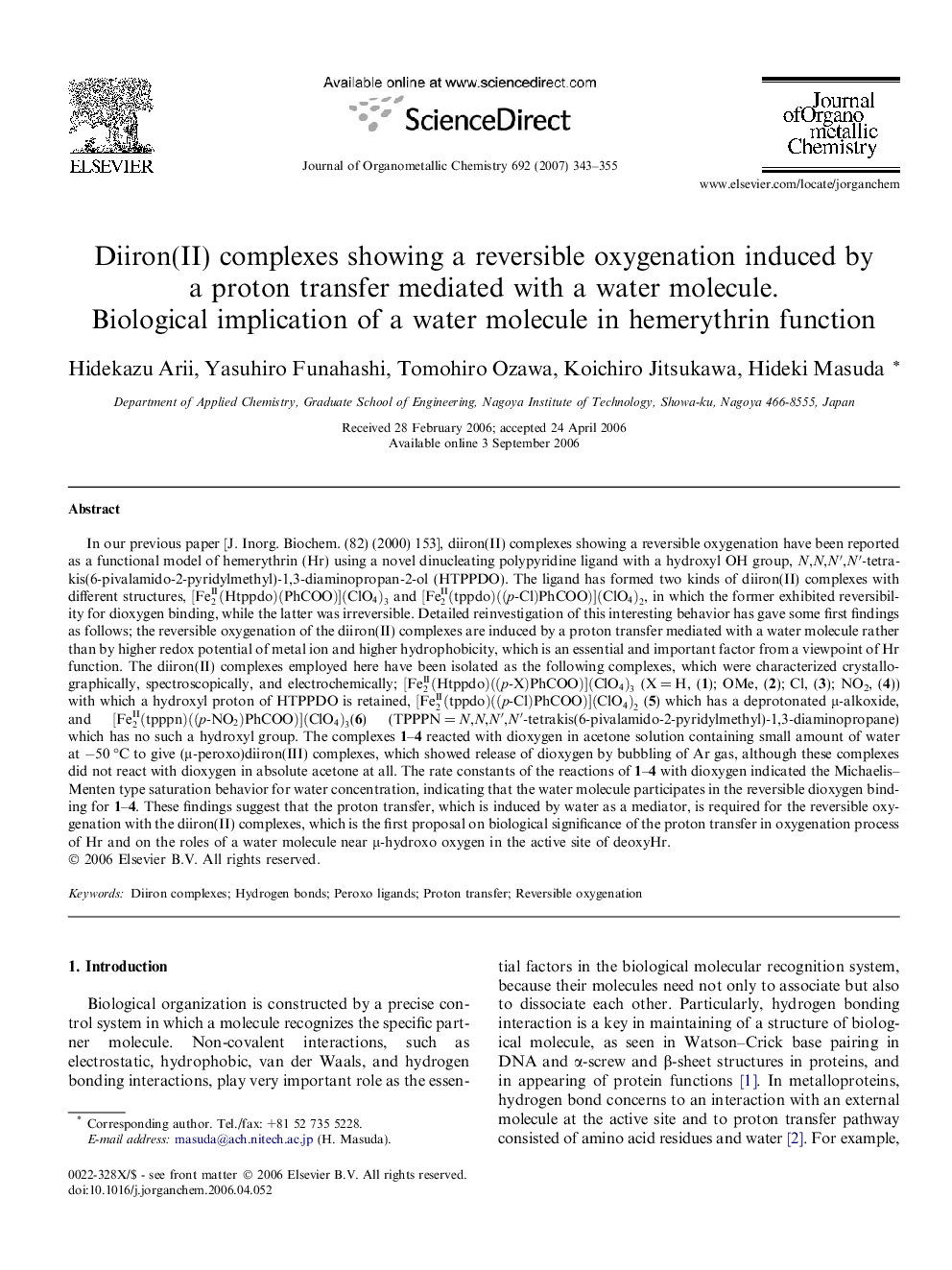| کد مقاله | کد نشریه | سال انتشار | مقاله انگلیسی | نسخه تمام متن |
|---|---|---|---|---|
| 1328325 | 1499949 | 2007 | 13 صفحه PDF | دانلود رایگان |

In our previous paper [J. Inorg. Biochem. (82) (2000) 153], diiron(II) complexes showing a reversible oxygenation have been reported as a functional model of hemerythrin (Hr) using a novel dinucleating polypyridine ligand with a hydroxyl OH group, N,N,N′,N ′-tetrakis(6-pivalamido-2-pyridylmethyl)-1,3-diaminopropan-2-ol (HTPPDO). The ligand has formed two kinds of diiron(II) complexes with different structures, [Fe2II(Htppdo)(PhCOO)](ClO4)3 and [Fe2II(tppdo)((p-Cl)PhCOO)](ClO4)2, in which the former exhibited reversibility for dioxygen binding, while the latter was irreversible. Detailed reinvestigation of this interesting behavior has gave some first findings as follows; the reversible oxygenation of the diiron(II) complexes are induced by a proton transfer mediated with a water molecule rather than by higher redox potential of metal ion and higher hydrophobicity, which is an essential and important factor from a viewpoint of Hr function. The diiron(II) complexes employed here have been isolated as the following complexes, which were characterized crystallographically, spectroscopically, and electrochemically; [Fe2II(Htppdo)((p-X)PhCOO)](ClO4)3 (X = H, (1); OMe, (2); Cl, (3); NO2, (4)) with which a hydroxyl proton of HTPPDO is retained, [Fe2II(tppdo)((p-Cl)PhCOO)](ClO4)2 (5) which has a deprotonated μ-alkoxide, and [Fe2II(tpppn)((p-NO2)PhCOO)](ClO4)3(6) (TPPPN = N,N,N′,N′-tetrakis(6-pivalamido-2-pyridylmethyl)-1,3-diaminopropane) which has no such a hydroxyl group. The complexes 1–4 reacted with dioxygen in acetone solution containing small amount of water at −50 °C to give (μ-peroxo)diiron(III) complexes, which showed release of dioxygen by bubbling of Ar gas, although these complexes did not react with dioxygen in absolute acetone at all. The rate constants of the reactions of 1–4 with dioxygen indicated the Michaelis–Menten type saturation behavior for water concentration, indicating that the water molecule participates in the reversible dioxygen binding for 1–4. These findings suggest that the proton transfer, which is induced by water as a mediator, is required for the reversible oxygenation with the diiron(II) complexes, which is the first proposal on biological significance of the proton transfer in oxygenation process of Hr and on the roles of a water molecule near μ-hydroxo oxygen in the active site of deoxyHr.
The diiron complex with the hydroxide group bound dioxygen reversibly accompanying proton transfer mediated by water, which indicates that proton transfer of μ-hydroxo to peroxo is an essential factor in the oxygenation of hemerythrin to play a role of dioxygen carrier.Figure optionsDownload as PowerPoint slide
Journal: Journal of Organometallic Chemistry - Volume 692, Issues 1–3, 1 January 2007, Pages 343–355